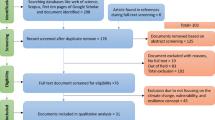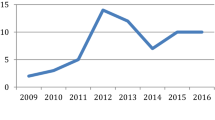Abstract
Vulnerability studies have evolved significantly in recent decades. Although not overly theoretical compared with some other fields of science, some important conceptual progress has been made. At the practical level, vulnerability indicators have been used either at a generic level or for particular hazard contexts. However, these indicators are often predictably too narrow in their coverage of aspects of vulnerability. An important need remains to produce more conceptually informed vulnerability indicators or parameters and more satisfactory operational tools to assess weaknesses and resilience in coping with natural risks. In this paper, we present the methodology developed in the context of a recently concluded EU funded project, ENSURE (Enhancing resilience of communities and territories facing natural and na-tech hazards). The resulting vulnerability and resilience assessment framework tool adopts a systemic approach embedding and integrating as much as possible the multifaceted and articulated nature of concepts such as vulnerability and resilience. The tool guides evaluators towards a comprehensive and context-related understanding of strengths and fragilities of a given territory and community with respect to natural extremes. In this paper, both the framework tool and its application to Sondrio in Italy, which is exposed to flash floods, are presented and discussed. The merits and demerits of the new tool are discussed, and the results of the application to Sondrio indicate where data are currently missing, suggesting the kind of data, which will need to be gathered in future to achieve more complete assessments. The results also suggest vulnerability reduction policies and actions and further ways of revising the existing framework tool in the future.


Similar content being viewed by others
References
Al-Kuwaiti M, Kyriakopoulos N, Hussein S (2006) Network dependability, fault-tolerance, reliability, survivability: a framework for comparative analysis. Proceedings of the 2006 international conference on computer engineering and systems, 5–7 November 2006, Cairo, Egypt
Armonia project (2007) Assessing and mapping multiple risks for spatial planning—approaches, methodologies and tools in Europe. http://ec.europa.eu/research/environment/pdf/publications/fp6/natural_hazards//armonia.pdf
Ballio F, Menoni S, Crotti G, Borsani D, De Marchi B, Menucci G, Molinari D (2010) Costruzione di un sistema di allarme a supporto del piano di emergenza in ambito montano. Technical report for the Province of Sondrio, Politecnico di Milano, Milano
Barroca B, Bernardar P, Mouchel J, Hubert G (2006) Indicators for identification of urban flooding vulnerability. Nat Hazard Earth Syst 6:553–561
Beck U (1992) Risk society: towards a new modernity. Sage, London
Blaikie P, Cannon T, Davis I, Wisner B (1994) At risk—natural hazards, people’s vulnerability and disasters, 2nd edn. Routledge, London
Calvi GM, Pinho R, Magenes G, Bommer JJ, Restrepo-Vélez LF, Crowley H (2006) Development of seismic vulnerability assessment methodologies over the past 30 years. J Earthq Technol 43(3):75–104
Chaviteau C, Vinet F (2006) Vulnérabilité des établissement recevant du public et des enterprises face aux indondations: une method d’analyse appliqué dans le basin de l’Horbe (Hérault). Ingénieries 46:15–33
Cruetin JD, Borga M, Lutoff C, Scolobig A, Ruin I, Creton-Cazanave L (2009) Catchment dynamics and social response during flash floods: the potential of radar rainfall monitoring for warning procedures. J Appl Meteorol 16:115–125
Cuny FC (1983) Disasters and development. Oxfam and Oxford University Press, New York
Cutter SL (2006) Hazards, vulnerability and environmental justice. Earthscan Publication, London, Sterling, VA
Cutter SL, Mitchell JT, Scott MS (2000) Revealing the vulnerability of people and places: a case study of Georgetown County, South Carolina. Ann As Am Geogr 90(4):713–737
Cutter SL, Barnes L, Berry M, Burton C, Evans E, Tate E, Webb J (2008) A place-based model for understanding community resilience to natural disasters. Global Environ Chang 18(4):598–606
Cyranoski D (2011) Japan faces up to failure of its earthquake preparations. Nature 471:556–557
Defra/Environment Agency (2006) Flood risks to people, FD2321/TR guidance document. Defra, London
Fowler HJ, Kilsby CG, O’Connell PE (2003) Modeling the impacts of climatic change and variability on the reliability, resilience and vulnerability of a water resource system. Water Resour Res. doi:10.1029/2002WR001778
Galderis A, Menoni S (2007) Rischi naturali, prevenzione, piano. Urbanistica. Rivista semestrale dell’Istituto Nazionale di Urbanistica 20–23 (the English translation is available in the Journal)
Galli M, Guzzetti F (2007) Landslide vulnerability criteria: a case study from Umbria, Central Italy. Environ Manage 40:649–664
Granger K, Jones T, Leiba M, Scott G (1999) Community risk in Cairns—a multihazard risk assessment. AGSO, Canberra
Guha-Sapri D, Santos I (2012) The economic impacts of natural disasters. Oxford University Press, Oxford
Hewitt K (ed) (1983) Interpretations of Calamity, the risks and hazard series: 1. George, Allen and Unwin, London
Hills A (2005) Insidious environments: creeping dependencies and urban vulnerabilities. J Conting Crisis Manage 13(1):12–20
Holling CS (1973) Resilience and stability of ecological systems. Annu Rev Ecol Syst 4:1–23
Holling CS (1996) Engineering resilience versus ecological resilience. In: Schulze PC (ed) Engineering with ecological constrains. National Academy Press, Washington, DC
Holling CS (2001) Understanding the complexity of economic, ecological, and social system. Ecosystems 4:390–405
IDNDR (1999) A Safer world in the 21st century: disaster and risk reduction. IDNDR programme forum, Geneva
Inter-American Development Bank (2010) The economics of natural disasters: a survey, IDB working paper series No IDB-WP-124, IDB, New York
IPCC (2001) Climate change 2001. Synthesis report. A contribution of Working Groups I, II and III to the third assessment report of the intergovernmental panel on climate change. In Watson RT et al (eds) Cambridge University Press, Cambridge, p 398
Kelman I, Spence R (2004) An overview of flood actions on buildings. Eng Geol 73(3–4):297–309
King D, Moloney J, MacGregor C (2000) A review of the community vulnerability in the cairns multi-hazard risk assessment, center for disaster studies. James Cook University, Townsville
Kininmonth W (2005) Climate change: a natural hazard. Multi-Science Publishing Co, UK
Ledoux B (1999) Guide pour la conduite des diagnostiques de vulnérabilité aux inondations pour les entreprises industrielles. Ministère de l’Aménagment du Territoire et de l’Environment, France
Longstaff P, Armstrong NJ, Parrin K, Parker W, Hidek M (2010) Building resilient communities: a preliminary framework for assessment. Homel Secur Aff VI-3:1–22
Messner F, Meyer V (2006) Flood damage, vulnerability and risk perception–challenges for flood damage research. Flood risk management: hazards, vulnerability and mitigation measures. NATO Sci Ser IV Earth Environ Sci 67(4):149–167
Meyer V, Messner F (2005) National flood damage evaluation methods: a review of applied methods in England, the Netherlands, the Czech Republic and Germany, UFZ discussion paper 21/2005, Department of Economics. http://www.ufz.de/data/dp2120053680.pdf
Mihelcic JR, Crittenden JC, Small MJ, Shonnard DR, Hokanson DR, Zhang Q, Chen H, Sorby SA, James VU, Sutherland JW, Schnoor JL (2003) Sustainability science and engineering: emergence of a new metadiscipline. Environ Sci Technol 37(23):5314–5324
Mitchell J (1999) Crucibles of hazards: mega-cities and disasters in transition. United Nations University, Tokyo
Molinari D, Ballio F, Menoni S (2011) Flood forecast verification to support emergency management, Proceedings of 34th IAHR world congress, 26 June–1 July, 2011, Brisbane, Australia
Norris F, Stevens S, Pfefferbaum B, Wyche K, Pfefferbaum R (2008) Community resilience as a metaphor, theory, set of capacities, and strategy for disaster readiness. Am J Commun Psychol 41:127–150
O’Keefe P, Westgate K, Wisner B (1976) Taking the naturalness out of natural disaster. Nature 260(5552):566–567
Ostrom E (2005) Understanding institutional diversity. Princeton University Press, Princeton NJ
Parker D, Handmer J (1996) The role of unofficial flood warning systems. J Conting Crisis Manage 6(1):45–60
Paton D (2008) Community resilience: integrating individual, community and societal perspective. In: Gow K, Paton D (eds) The phoenix of natural disasters: community resilience. Nova Science Publishers Inc., Hauppauge NY, pp 13–31
Perrow C (1984) Normal accidents. Living with high risk technologies. Basic Books, New York, NY
Petrini V (1996) Overview report in vulnerability assessment. Proceedings of the fifth international conference on seismic zonation, Edition Ouést, Paris
Pielke RA (2000). Flood impacts on society. Damaging floods as a framework for assessment. In Parker D (ed) Floods, vol 1. Routledge, New York
Roberts N, Nadim F, Kalsnes B (2007) Quantification of vulnerability to natural hazards. Georisk 3(3):164–173
Rockström J (2003) Resilience building and water demand management for drought mitigation. Phys Chem Earth 28:869–887
Schwarz J, Maiwald H (2008) Damage and loss prediction model based on the vulnerability of building types. Proceedings of the 4th international symposium on flood defence: managing flood risk, reliability and vulnerability. 6–8 May, Toronto, Canada
Segnestam L (1999) Environmental performance indicators—a second edition note. The World Bank, Environment Department
Spence RJS, Kelman I, Baxter PJ, Zuccaro G, Petrazzuoli (2005) Residential building and occupant vulnerability to tephra fall. Nat Hazard Earth Syst 5:477–494
Tobin G, Montz B (1997) Natural hazards: explanation and integration. The Guildford Press, New York
Torry W (1978) Natural disasters, social structure and change in traditional societies. J Asian Afr Stud 13:167–183
UNDRO (1979) Natural disasters and vulnerability analysis—Report of expert group. UNDRO, Geneva
Van Westen CJ, Van Asch TWJ, Soeters R (2006) Landslide hazard and risk zonation—why is it still so difficult? B Eng Geo Environ. 65(2):167–184
White G, Kates R, Burton I (2001) Knowing better and losing even more: the use of knowledge in hazard management. Environ Hazards 3(3):81–92
Xanthopoulos G (2003) Factors affecting the vulnerability of houses to wildland fire in the Mediterranean region. Proceedings of the international workshop forest fires in the wildland-urban interface and rural areas in Europe, 15–16 May, Athens, Greece
Xanthopoulos G (2007) Forest fire policy scenarios as a key element affecting the occurrence and characteristics of fire disasters. Proceedings of the 4th international wildland fire conference, 13–17 May, Sevilla, Spain
Zuccaro G, Ianniello D (2004) Interaction of pyroclastic flows with building structures in an urban settlement: a fluid-dynamic simulation impact model. J Volcanol Geoth Res 133(1–4):345–352
Website
Acknowledgments
Authors acknowledge with gratitude the contribution of the ENSURE partners in the development of the framework. Moreover, we are grateful to Chiara Fonio and Marco Lombardi (from Università Cattolica in Milan) and Bruna De Marchi for their support in the analysis of Sondrio’s social vulnerability. Finally, we are grateful to the students of CERM (at Politecnico di Milano) who produced the map in Fig. 2.
Author information
Authors and Affiliations
Corresponding author
Electronic supplementary material
Below is the link to the electronic supplementary material.
Rights and permissions
About this article
Cite this article
Menoni, S., Molinari, D., Parker, D. et al. Assessing multifaceted vulnerability and resilience in order to design risk-mitigation strategies. Nat Hazards 64, 2057–2082 (2012). https://doi.org/10.1007/s11069-012-0134-4
Received:
Accepted:
Published:
Issue Date:
DOI: https://doi.org/10.1007/s11069-012-0134-4




